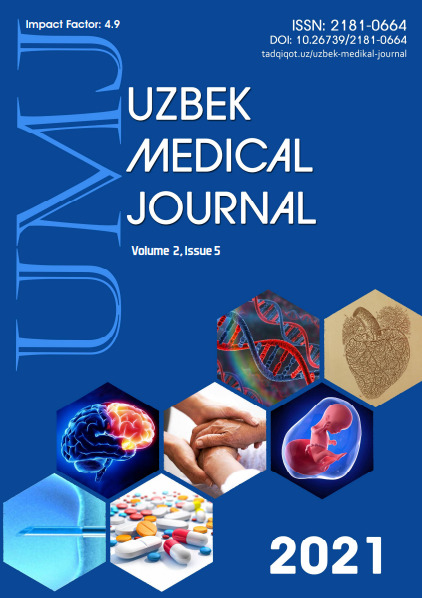СОВРЕМЕННАЯ ТЕХНИКА ОСТЕОСИНТЕЗА ПРИ ПРОКСИМАЛЬНЫХ ПЕРЕЛОМАХ ПЛЕЧЕВОЙ КОСТИ
Ключевые слова:
плечо, проксимальный, минимально инвазивный, остеосинтез, проксимальный, деформированный, акромион, передние, проксимальные переломы, синдромАннотация
В этой статье обсуждаются вопросы выбора метода лечения при переломах проксимальной части плечевой кости, о том, как предлагаемый малоинвазивный метод остеосинтеза при переломах проксимальной части плечевой кости позволяет менее травматичное репозирование костных отломков, более стабильную фиксацию костных отломков, а менее инвазивный метод остеосинтеза при переломах проксимальной части плечевой кости позволяет менее травматичное репозирование костных отломков, более стабильную фиксацию костных отломков.Улучшить результаты лечения путем разработки малоинвазивного метода экстрамедуллярного лечения при переломах проксимального отдела плечевой кости. Эта исследовательская работа была проведена на клинических базах филиала РИТОИАМ и РШТЁИМ Бухарский у пациентов с множественными фрагментарными переломами проксимальной части плечевой кости в общей сложности 40, у 15 из которых было обнаружено, что они находятся в состоянии варуса костных фрагментов. Пациенты были разделены по полу: 15 мужчин и 25 женщин. Продолжительность поездки составила в среднем 5,8±1,8 дня (3-7 дней). Для оценки состояния костных фрагментов при многооскольчатых переломах у пациентов использовалась классификация Neer (1970): однооскольчатые, 10 (25%) – двухоскольчатые, 12 (30%) – трехоскольчатые и оставшиеся 12 (30%) – многооскольчатые переломы у 6 (15 %) пациентов. При переломах проксимального отдела плечевой кости остеосинтез выполнялся менее инвазивной блокирующей пластиной с помощью разработанного в клинике внешнего дистракционного аппарата и разреза раны небольшого размера.
Библиографические ссылки
Klyuchevsky V.V., Shkrebko A.N., Borisova N.V. Stress treatment after shoulder joint surgery. Medicine and Sport. 2006; (1): 19-20.
Eldzarov P.E., Zelyanin A.S., Filippov V.V. Surgical treatment of patients with the consequences of fractures of the humerus. Surgery. 2010; (9): 47–52.
Minaev A.N., Gorodnichenko A.I., Uskov O.N. Transosseous osteosynthesis of fractures of the proximal metaepiphysis of the humerus in elderly and senile patients. Surgery. 2010; (1): 50–53.
Khakimov Sh.K., Rakhimov Zh.K. Minimally invasive intramedullary osteosynthesis in the treatment of fractures of the surgical neck of the humerus in children. Materials of the conference "Organizational and clinical issues of patient care in traumatology and orthopedics". 2018; 129-131.
Alimov A.P., Yusupov S.Yu., Hakimov Sh.K. / A modern view on the surgical treatment of proximal humerus fractures (Literature review). // ejmpr, 2020,7(12),10-15.
Boudard G., Pomares G., Milin L., et al. Locking plate fixation versus antegrade nailing of 3- and 4-part proximal humerus fractures in patients without osteoporosis. Comparative retrospective study of 63 cases. Orthop. Traumatol. Surg. Res. 2014; 100(8): 917–924. doi: 10.1016/j.otsr.2014.09.021.
G. B. Yan, “Neer Classification of proximal humeral fracture,” Chinese Journal of Joint Surgery, vol. 2, article 267, 2011.
J. Dai, Y. Chai, C. Wang, and G. Wen, “Meta-analysis comparing locking plate fixation with hemiarthroplasty for complex proximal humeral fractures,” European Journal of Orthopaedic Surgery and Traumatology, vol. 24, no. 3, pp. 305–313, 2014.
Joshi RR, Narang S, Sundararaj GD. / Fractures of the proximal humerus in children and adolescents. // J Lumbini Med Coll, 2013;1(2):71-75.
L. P. Shang, F. Zhou, H. Q. Ji, and Z. S. Zhang, “Comparison of curative effects between minimally invasive locking plate internal fixation and open reduction with internal fixation for the treatment of proximal humerus fractures,” Journal of Peking Unviersity, vol. 45, no. 5, pp. 711–716, 2013.
Lekic N., Montero N.M., Takemoto R.C., et al. Treatment of two-part proximal humerus fractures: intramedullary nail compared to locked plating. HSS J. 2012; 8(2): 86–91. doi : 10.1007/s11420-012-9274-z.
Siebenbürger G., Van Delden D., Helfen T., et al. Timing of surgery for open reduction and internal fixation of displaced proximal humeral fractures. Injury. 2015; 46 (Suppl 4): S58-S62. doi : 10.1016/S00201383(15)30019-X.
Song J.Q., Deng X.F., Wang Y.M., et al. Operative vs. nonoperative treatment for comminuted proximal humeral fractures in elderly patients: a current meta-analysis. Acta Orthop. Traumatol. Turc. 2015; 49(4): 345–353. doi : 10.3944/AOTT.2015.14.0451.
T. Lin, B. Xiao, X. Ma, D. Fu, and S. Yang, “Minimally invasive plate osteosynthesiswith a locking compression plate is superior to open reduction and internal fixation in the management of the proximal humerus fractures,” BMCMusculos keletal Disorders, vol. 15, no. 1, article 206, 2014.
Tamimi I., Montesa G., Collado F., et al. Displaced proximal humeral fractures: when is surgery necessary? Injury. 2015; 46(10): 1921–1929. doi : 10.1016/j.injury.2015.05.049.
Wei Zhao et al. / Comparison of Minimally Invasive Percutaneous Plate Osteosynthesis and Open Reduction Internal Fixation on Proximal Humeral Fracture in Elder Patients: A Systematic Review and Meta-Analysis. // Hindawi BioMed Research International. 2017; pages 7.
Wronka K.S., Ved A., Mohanty K. When is it safe to reduce fracture dislocation of shoulder under sedation? Proposed treatment algorithm. Eur. J. Orthop. Surg. Traumatol. 2017; 27(3): 335–340. doi : 10.1007/ s00590-016-1899-z.

